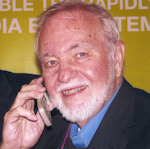Automatic Digital Antenna Tuning Fits Multiple Wireless Applications
Peregrine Semiconductor’s DuNE technology solves one of the orneriest problems in RF design—antenna impedance matching. In every wireless application, an antenna has to be connected to the radio. That invariably means the imposition of some kind of impedance- matching circuit between the transmitter/receiver and the antenna.
Impedance matching is essential for maximum power output/ input, minimum voltage standing-wave ratio (VSWR) loss, and improved efficiency. Fixed-value capacitors and inductors are commonly used to perform that match with various forms of T, L, or p networks. While they work well, they cannot compensate for the environmental changes that invariably detune the antenna and kill efficiency.
For example, when you place your cell phone to your ear, your body detunes the antenna. Other nearby objects can also affect it. The problem is particularly acute in multiband, multimode handsets that must operate over a wide range of frequencies. In most cases, the radio is always operating with a detuned antenna. The VSWR in a typical handset is rarely better than 3:1 (2 dB loss) and can increase to 5:1 (3.5 dB loss) when filters, switches, or duplexers are added in. When users put their finger on the handset antenna, they can send the VSWR to 9:1, severely reducing power and efficiency.
This Z-match problem has been solved over the years in higher-power transmitters and larger equipment with variable capacitors or inductors in a feedback network that automatically compensates for changes in antenna orientation, impedance variations, or frequency changes. Now these techniques can be brought to cell phones and other mobile products thanks to the DuNE technology.
The solution to the impedance- matching problem is essentially a variable capacitor that’s small enough to fit in the handset and be controlled by internal circuitry. Varactors (voltage variable capacitors) have been used, as have microelectromechanical systems (MEMS) switched capacitor banks. But both of these options require 30 to 40 V for operation—not easy to come by in a handset.
The DuNE chip sol ves this problem with MOSFET switched capacitors that permit higher-frequency operation, faster switching, and higher Q. The DuNE digitally tunable capacitor (DTC) chip contains five capacitors switched by MOSFETs that operate from a serial input bus with a 5-bit code providing 32 possible capacitor values (see the figure).
The capacitor values can range from 0.5 to 10 pF with typical tuning ratios of 3:1 to 6:1, or 10:1 in some cases. Typical switching speed is less than 5 µs. Capacitor Qs greater than 100 are possible. The frequency range is up to 3 GHz, and power handling is up to 40 dBm. The chip operates with a supply voltage of 2.4 to 3.0 V with current consumption in the 20- to 100-µA range. The device comes in a 2- by 2-mm dual flat no-lead (DFN) 8L flip-chip or plastic package.
One or more DuNE chips can be used in an L, T, or p network for matching in 50-O devices. The chip can be used in an open-loop fashion with input control from a lookup table or in a closed-loop adaptive tuning network. The closedloop system uses a directional coupler to sense forward and reflective power. A tuning algorithm is implemented to provide automatic adjustment to bring the VSWR to its lowest possible value.
DuNE also is ideal for mobile TV receivers that must operate over wide frequency ranges. The European DVB-H and Japanese ISDB-T mobile TV systems must commonly operate in the 470- to 862-MHz range, creating a massive detuning problem with channel selection.
LOUIS E. FRENZEL
PEREGRINE SEMICONDUCTOR
www.psemi.com
